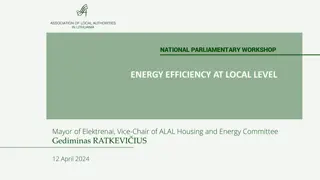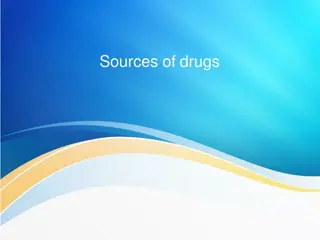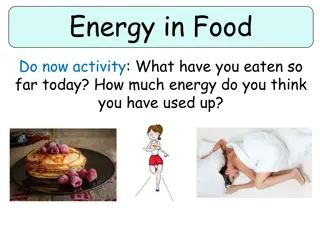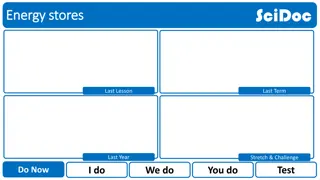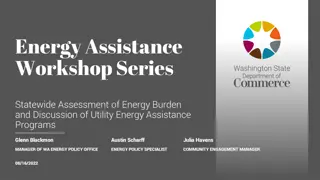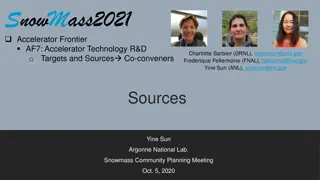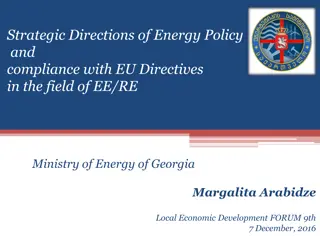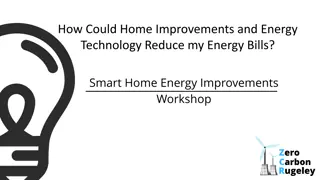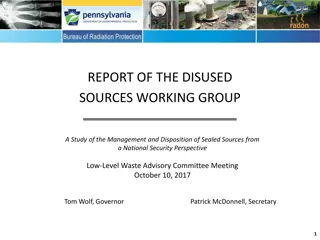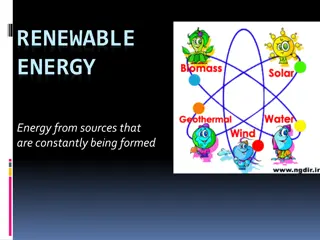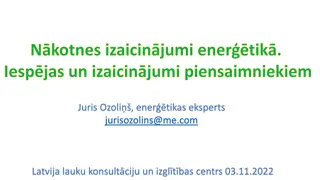Energy: Sources, Transformation, and Utilization
Explore the concept of energy through topics like the origin of matter in trees, cellular respiration, concentrated vs. spread energy resources, energy sources in the US, energy utilization, and harnessing latent heat. Dive into how energy is generated, transformed, and used in various forms across nature and technologies.
Download Presentation

Please find below an Image/Link to download the presentation.
The content on the website is provided AS IS for your information and personal use only. It may not be sold, licensed, or shared on other websites without obtaining consent from the author. Download presentation by click this link. If you encounter any issues during the download, it is possible that the publisher has removed the file from their server.
E N D
Presentation Transcript
Question A seed is planted in the ground. Over the years it grows into a larger tree. Where did most of the matter that makes up the tree come from? A. Ground B. Sunlight C. Carbon Dioxide D. Chlorophyll E. Water
What performs cellular respiration? A. Plants B. Animals C. Both plants and animals
Concentrated vs. Spread Energy Why do we need to be concerned about energy resources taking the first law of thermodynamics into mind? Energy can t be destroyed, why worry about it as a resource? The resources being discussed are concentrated sources of energy. They are easier for us to use. Around any house, even in the winter, there is a considerable amount of spread heat energy.
Spread energy Think about all the spread energy in your yard. That is energy that is spread out. All those gas molecules moving around. Objects at the top of the trees. Water rolling off your roof when it rains. What about the energy in grass clipping or leaves? This energy makes the wind blow, due to an uneven heating. This energy evaporates water and later causes rain/snow etc. It causes lightning and all other weather!!
Latent Heat We have devised a couple of ways of capturing some of this energy. There has to be better ways to harness more of this energy. A greenhouse is good at harnessing some of that energy.
Greenhouse Radiant energy from the sun comes mainly in the form of visible light (at least on the surface of Earth, there are other forms that are blocked out by our atmosphere). Visible light passes right through the glass walls of the greenhouse. It heats the ground inside. The ground cools off mainly by convection of air. Air can t get out of the greenhouse so this doesn t work.
Greenhouse cont. Energy is also released by radiation. The ground normally releases energy as infrared radiation. IR light doesn t pass through the glass very well. Therefore the inside keeps heating up, concentrating all of the spread energy. Cars accidently use this in the summer if the windows are up. Solar cookers use this principle purposefully.
Cont. When you open the door to the solar cooker, all the energy you just concentrated rushes back to being spread energy. It is felt as a gush of wind coming out. This is because the hot air inside quickly mixes with the cooler air.
Greenhouse Effect ~Trapping of heat energy on the planet by certain gases The major greenhouse gases are carbon dioxide, water vapor and methane. Without these gases we would die because we would freeze to death at night. The moon is the same distance from the sun and -170oC at night. With too much of these gases, our planet will heat up. The planet heating up is called global warming.
Greenhouse Effect Visible light energy comes to the Earth from the sun. This light passes right through the atmosphere unaffected. It then heats up the ground. Objects on Earth give off heat as infrared rays at the temperatures they are heated to. These rays go out from the ground. Greenhouse gases stop the infrared rays from escaping easily, and reflect many of them back so more heat energy is trapped on the planet.
Carbon Cycle Carbon is in a cycle throughout our planet. It is found as carbon dioxide in the air. The carbon is taken out of the air and used to build plants, like all life forms plants are carbon based. Animals eat the plants and use the carbon to build themselves (proteins). Plants and animals may release their carbon back into the atmosphere as CO2 through cellular respiration, as they decay or if they are burned.
Fossil Fuels Fossils fuels are a very convenient form of concentrated energy. Major fossil fuels used today are petroleum, natural gas and coal. Petroleum can be distilled into gasoline, kerosene, and diesel fuel. The current deposits were formed when plants and animals were buried about 500 million years ago. These plants and animals took CO2from the atmosphere and energy from the sun 500 million years ago and stored it in the Earth.
Petroleum Normally plants and animals return their energy and carbon to the planet , but these were shut off from the world when they were buried. Normal decomposers didn t get to release their energy back to the planet. So it sat there stored from millions of years. The pressure over time concentrated the energy source. Once discovered, people found several uses for these concentrated stored energy sources.
The problem is rising CO2levels We release the ancient energy source (ancient sun energy), by burning it. When we do this it releases the carbon dioxide that has been out of our atmosphere for millions of years Try and find Industrial Revolution on the graph
So What! Carbon dioxide is a green house gas. Increased levels of CO2in the atmosphere cause the temperature of the planet to rise
Climate vs Weather Climate is the average weather for a given area. Climate is what you expect, weather is what you get The man walking the dog represents climate. The dog represents weather.
I like it warm This won t actually make every area warmer or this area tropical. The global average will be a few degrees warmer. You would still have cold days. Heat powers wind, weather systems, ocean currents etc. This will cause a global Climate Change. Some areas could get colder from this climate change, other areas could get warmer, but see higher snow falls.
But it was cold Did you look at the whole world or just where you live? This is the weather map when it was -17 with wind chill in Akron.
How much will the planet heat up? only a few degrees (we won t burn to death) But this could cause changes that can be very expensive and damaging. You could expect ocean acidification, flooding of coastal areas and massive losses of crops, and increase in hurricanes and lots of things we didn t expect. A big concern is the unexpected. There are too many variables to be absolutely sure what will happen if the planet heats up.
Isnt there disagreement on this? There is disagreement on how much the planet will increase in temperature, not that it is increasing. The planet has already slightly increased in temperature. There is disagreement on what the new climates will actually be. Certain areas could benefit from a climate change, while others will be devastated. There is disagreement on what different areas will change to, not that they will change.
NOAA ranking of warmest years from 1880-2019 Anomaly C Rank Year 2016 0.99 C 1 2019 0.95 C 2 2015 0.93 C 3 2017 0.91 C 4 2018 0.83 C 5 Click on this link https://www.ncdc.noaa.gov/cag/global/ time- series/globe/land_ocean/ytd/12/1880- 2019 2014 0.74 C 6 2010 0.72 C 7 2005 0.67 C 8 2013 0.67 C 9 1998 0.65 C 10 2003 0.64 C 11 2006 0.64 C 12 13
China v US China surpassed the United States in energy consumption in 2010
https://en.wikipedia.org/wiki/List_of_countries_by_carbon_dioxide_emissions
World Population http://www.census.gov/popclock/ https://en.wikipedia.org/wiki/List_of_countries_by_carbon_dioxide_emissions
Past Climate Changes We are a few degrees warmer than the last ice age. In the last ice age, a glacier covered most of Ohio. It is a subtle shift in climate change that changes a fertile growing area into a desert.
Misnomers The planet will NOT be destroyed. It can handle anything we do to it. The question is, can the human population survive the changes? If so, how much of the population will survive? If there are not enough resources to go around, can we expect war? We are an incredibly adaptable species, but entire civilizations have been wiped out by climate shifts. Just ask the Mayans oh wait you can t, they are all dead.

 undefined
undefined






